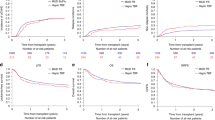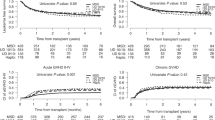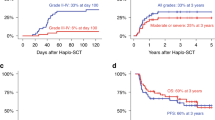Abstract
There are no data indicating whether the number of induction courses needed to achieve first complete remission (CR1) is of prognostic significance in Haploidentical transplantation (HaploSCT). We compared transplantation outcomes of adults with AML that underwent HaploSCT in CR1, achieved following one or two induction courses. A total of 635 patients were included: 469 (74%) with 1 and 166 (26%) with two induction chemotherapy courses. A total of 429 (91.5%) and 151 (91%) patients had de novo AML and 40 (8.5%) and 15 (9%) had secondary AML (p = 0.84). Engraftment rates were 97.2 and 97.6%. Day 180 incidence of acute GVHD II-IV and III-IV was similar in both induction groups (31.1 and 34.8%, and 10 and 10.6 %), as was 2–4 year total and extensive chronic GVHD (33.7 and 36.5 %, and 12.2 and 12.1%), respectively. Two-year relapse incidence (RI) was higher while leukemia-free survival (LFS), overall survival (OS) and GVHD-free, relapse-free survival (GRFS) were inferior for patients achieving CR1 with 2 vs 1 course and were 29.1% vs 15.1%, 88 (p = 0.001), 56.2% vs 66.9% (p = 0.03), 58.8% vs 72.2% (p = 0.044) and 44% vs 55.6% (p = 0.013), respectively. Non-relapse mortality (NRM) did not differ, 18% vs 14.6% 90 (p = 0.25). These results were confirmed by multivariate analysis.
This is a preview of subscription content, access via your institution
Access options
Subscribe to this journal
Receive 12 print issues and online access
$259.00 per year
only $21.58 per issue
Buy this article
- Purchase on Springer Link
- Instant access to full article PDF
Prices may be subject to local taxes which are calculated during checkout

Similar content being viewed by others
References
Dohner H, Weisdorf DJ, Bloomfield CD. Acute myeloid leukemia. N. Engl J Med. 2015;373:1136–52.
Yates JW, Wallace HJ, Ellison RR, Holland JF. Cytosine arabinoside (NSC-63878) and daunorubicin (NSC-83142) therapy in acute nonlymphocytic leukemia. Cancer Chemother Rep. 1973;57:485–8.
Yates J, Glidewell O, Wiernik P, Cooper MR, Steinberg D, Dosik H, et al. Cytosine arabinoside with daunorubicin or adriamycin for therapy of acute myelocytic leukemia: a CALGB study. Blood. 1982;60:454–62.
Stein EM, Tallman MS. Remission induction in acute myeloid leukemia. Int J Hematol. 2012;96:164–70.
Passweg JR, Baldomero H, Bader P, Bonini C, Duarte RF, Dufour C, et al. Use of haploidentical stem cell transplantation continues to increase: the 2015 European Society for Blood and Marrow Transplant activity survey report. Bone Marrow Transpl. 2017;52:811.
Kasamon YL, Bolaños-Meade J, Prince GT, Tsai HL, McCurdy SR, Kanakry JA, et al. Outcomes of nonmyeloablative HLA-haploidentical blood or marrow transplantation with high-dose post transplantation cyclophosphamide in older adults. J Clin Oncol. 2015;33:3152–61.
McCurdy SR, Kanakry JA, Showel MM, Tsai HL, Bolaños-Meade J, Rosner GL, et al. Risk-stratified outcomes of nonmyeloablative HLA-haploidentical BMT with high-dose posttransplantation cyclophosphamide. Blood. 2015;125(May):3024–31.
Ciurea SO, Zhang MJ, Bacigalupo AA, Bashey A, Appelbaum FR, Aljitawi OS, et al. Haploidentical transplant with posttransplant cyclophosphamide vs matched unrelated donor transplant for acute myeloid leukemia. Blood. 2015;126(Aug):1033–40.
Piemontese S, Boumendil A, Labopin M, Schmid C, Ciceri F, Arcese W, et al. Leukemia relapse following manipulated haploidentical transplantation: a risk factor analysis on behalf of the ALWP of the EBMT. J Hematol Oncol. 2019;12(Jul):68.
Shouval R, Fein JA, Labopin M, Kröger N, Duarte RF, Bader P, et al. Outcomes of allogeneic haematopoietic stem cell transplantation from HLA-matched and alternative donors: a European Society for Blood and Marrow Transplantation registry retrospective analysis. Lancet Haematol. 2019;6:e573–e584.
Battipaglia G, Boumendil A, Labopin M, Ciceri F, Tischer J, Stelljes M, et al. Unmanipulated haploidentical versus HLA-matched sibling allogeneic hematopoietic stem cell transplantation in relapsed/refractory acute myeloid leukemia: a retrospective study on behalf of the ALWP of the EBMT. Bone Marrow Transpl. 2019;54:1499–510.
Nagler A, Baron F, Labopin M, Polge E, Esteve J, Bazarbachi A, et al. Measurable residual disease (MRD) testing for acute leukemia in EBMT transplant centers: a survey on behalf of the ALWP of the EBMT. Bone Marrow Transplant. 2021;56:218–24.
Canaani J, Labopin M, Huang XJ, Ciceri F, Van Lint MT, Bruno B, et al. Minimal residual disease status predicts outcome of acute myeloid leukaemia patients undergoing T-cell replete haploidentical transplantation. An analysis from the Acute Leukaemia Working Party (ALWP) of the European Society for Blood and Marrow Transplantation (EBMT). Br J Haematol. 2018;183:411–20.
Pagani IS, Ross DM, Park S, Yong ASM, Braley JA, Altamura HK, et al. Early BCR-ABL1 kinetics are predictive of subsequent achievement of treatment-free remission in chronic myeloid leukemia. Blood. 2021;137:1196–207.
Rowe JM, Kim HT, Cassileth PA, Lazarus HM, Litzow MR, Wiernik PH, et al. Adult patients with acute myeloid leukemia who achieve complete remission after 1 or 2 cycles of induction have a similar prognosis: a report on 1980 patients registered to 6 studies conducted by the Eastern Cooperative Oncology Group GROUP. Cancer. 2010;116:5012–21.
Bacigalupo A, Ballen K, Rizzo D, Giralt S, Lazarus H, Ho V, et al. Defining the intensity of conditioning regimens: working definitions. Biol Blood Marrow Transpl. 2009;15:1628–33.
Przepiorka D, Weisdorf D, Martin P, Klingemann HG, Beatty P, Hows J, et al. 1994 consensus conference on acute GVHD grading. Bone Marrow Transpl. 1995;15:825–8.
Shulman HM, Sullivan KM, Weiden PL, McDonald GB, Striker GE, Sale GE, et al. Chronic graft-versus-host syndrome in man. A long-term clinic pathologic study of 20 Seattle patients. Am J Med. 1980;69:204–17.
Ruggeri A, Labopin M, Ciceri F, Mohty M, Nagler A. Definition of GvHD-free, relapse-free survival for registry-based studies: an ALWP-EBMT analysis on patients with AML in remission. Bone Marrow Transpl. 2016;51:610–1.
Abraham SK, Arnon N, Bipin S. Summary of scientific and statistical methods, study endpoints and definitions for observational and registry-based studies in hematopoietic cell transplantation. Clin Hematol Int. 2019;2:2–4.
Andersen PK, Klein JP, Zhang MJ. Testing for center effects in multi-center survival studies: a Monte Carlo comparison of fixed and random effects tests. Stat Med. 1999;18:1489–500.
R Core Team. R: a language and environment for statistical computing. Vienna: R Foundation for Statistical Computing. 2017. https://www.R-project.org/.
Package ‘MatchIt’. https://cran.r-project.org/web/packages/MatchIt/index.html (2015). Accessed May 2015.
Cornelissen JJ, Gratwohl A, Schlenk RF, Sierra J, Bornhäuser M, Juliusson G, et al. The European LeukemiaNet AML Working Party consensus statement on allogeneic HSCT for patients with AML in remission: an integrated-risk adapted approach. Nat Rev Clin Oncol. 2012;9:579–90.
Dholaria B, Savani BN, Hamilton BK, Oran B, Liu HD, Tallman MS, et al. Hematopoietic cell transplantation in the treatment of newly diagnosed adult acute myeloid leukemia: an evidence-based review from the american society of transplantation and cellular therapy. Biol Blood Marrow Transplant. 2021:27:6–20.
Othus M, Sudipto M, Sekeres MA, Godwin J, Anderson JE, Petersdorf P, et al. Prediction of CR following a second course of “3 + 7” in patients with newly diagnosed acute myeloid leukemia not in CR after a first course. Leukemia. 2016;30:1779–80.
Estey E. Management of persistent AML at day 14. Best Pract Res: Clin Haematol. 2014;27:235–40.
Ofran Y, Rowe JM. How many cycles of 7 + 3 and for whom? Leukemia. 2016;30:1796–179.
Ferguson P, Hills RK, Grech A, Betteridge S, Kjeldsen L, Dennis M, et al. An operational definition of primary refractory acute myeloid leukemia allowing early identification of patients who may benefit from allogeneic stem cell transplantation. Haematologica 2016;101:1351–8.
Lim SJ, Lim MJ, Raptis A, Hou JZ, Farah R, Marks SM, et al. Inferior outcome after allogeneic transplant in first remission in high-risk AML patients who required more than two cycles of induction therapy. Am J Hematol. 2015;90:715–8.
Walter RB, Sandmaier BM, Storer BE, Godwin CD, Buckley SA, Pagel JM, et al. Number of courses of induction therapy independently predicts outcome after allogeneic transplantation for acute myeloid leukemia in first morphological remission. Biol Blood Marrow Transpl. 2015;21:373–8.
Wang Y, Liu DH, Liu KY, Xu LP, Zhang XH, Han W, et al. Impact of pre transplantation risk factors on post transplantation outcome of patients with acute myeloid leukemia in remission after haploidentical hematopoietic stem cell transplantation. Biol Blood Marrow Transpl. 2013;19:283–90.
Yu S, Huang F, Wang Y, Xu Y, Yang T, Fan Z, et al. Haploidentical transplantation might have superior graft-versus-leukemia effect than HLA-matched sibling transplantation for high-risk acute myeloid leukemia in first complete remission: a prospective multi center cohort study. Leukemia. 2020;34:1433–43.
Maurillo L, Bassan R, Cascavilla N, Ciceri F. Quality of response in acute myeloid leukemia: the role of minimal residual disease. Cancers. 2019;11:1417.
Øvlisen AK, Oest A, Bendtsen MD, Bæch J, Johansen P, Lynggaard LS, et al. Stringent or non-stringent complete remission and prognosis in acute myeloid leukemia: a Danish population-based study. Blood Adv. 2018;2:559–64.
Innes AJ, Woolley P, Szydlo RM, Lozano S, Fernando F, Bansal D, et al. Complete remission with incomplete count recovery (CRi) prior to allogeneic HCT for acute myeloid leukaemia is associated with a high non-relapse mortality. Leukemia. 2018;34:667–70.
Canaani J, Labopin M, Itälä-Remes M, Blaise D, Socié G, Forcade E, et al. Prognostic significance of recurring chromosomal abnormalities in transplanted patients with acute myeloid leukemia. Leukemia. 2019;33:1944–52.
Canaani J, Savani BN, Labopin M, Huang XJ, Ciceri F, Arcese W, et al. Donor age determines outcome in acute leukemia patients over 40 undergoing haploidentical hematopoietic cell transplantation. Am J Hematol. 2018;93:246–53.
Kantarjian H, Kadia T, DiNardo C, Daver N, Borthakur G, Jabbour E, et al. Acute myeloid leukemia: current progress and future directions. Blood Cancer J. 2021;11(Feb):41.
Acknowledgements
We thank all the European Society for Blood and Marrow Transplantation (EBMT) centers and national registries for contributing patients to this study (Supplementary appendix material). We also thank the data managers for their excellent work.
Author information
Authors and Affiliations
Contributions
AN, ML, JC, and MM designed the study, analyzed the data and wrote the manuscript. XH, DB, WA, MCA, GS, EF, FC, SG, EB, JS, AB, and IYA collected clinical data. All authors read and approved the final manuscript.
Corresponding author
Ethics declarations
Competing interests
The authors declare no competing interests.
Additional information
Publisher’s note Springer Nature remains neutral with regard to jurisdictional claims in published maps and institutional affiliations.
Supplementary information
Rights and permissions
About this article
Cite this article
Nagler, A., Labopin, M., Huang, Xj. et al. Non-T depleted haploidentical stem cell transplantation in AML patients achieving first complete remission after one versus two induction courses: a study from the ALWP/EBMT. Bone Marrow Transplant 57, 572–578 (2022). https://doi.org/10.1038/s41409-021-01537-x
Received:
Revised:
Accepted:
Published:
Issue Date:
DOI: https://doi.org/10.1038/s41409-021-01537-x
This article is cited by
-
Matched related versus unrelated versus haploidentical donors for allogeneic transplantation in AML patients achieving first complete remission after two induction courses: a study from the ALWP/EBMT
Bone Marrow Transplantation (2023)
-
Impact of pre-transplant induction and consolidation cycles on AML allogeneic transplant outcomes: a CIBMTR analysis in 3113 AML patients
Leukemia (2023)
-
Outcome of human umbilical cord blood stem cell transplantation (CBT) for acute myeloid leukemia in patients achieving first complete remission after one versus two induction courses: a study from the Acute Leukemia Working Party of the European Society for Blood and Marrow Transplantation (EBMT)
Bone Marrow Transplantation (2022)



